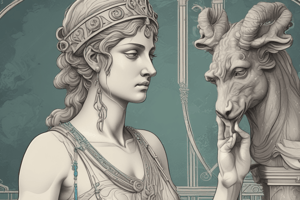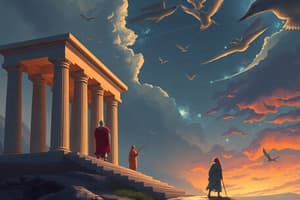Podcast
Questions and Answers
What is stratification?
What is stratification?
Part of the sampling process where units of the study are separated into strata.
What does 'terminus post quem' mean?
What does 'terminus post quem' mean?
The date after which; it refers to the earliest potential date for an artifact assemblage.
When was Pheidias's Cup created?
When was Pheidias's Cup created?
470-456 BC
What is the significance of Knossos Palace?
What is the significance of Knossos Palace?
What does the Knossos Central Court represent?
What does the Knossos Central Court represent?
What is the Knossos Throne Room known for?
What is the Knossos Throne Room known for?
What is depicted by the figurine known as the Snake Goddess?
What is depicted by the figurine known as the Snake Goddess?
What are lustral basins believed to have been used for?
What are lustral basins believed to have been used for?
What does the Bull Leaping Fresco depict?
What does the Bull Leaping Fresco depict?
What is depicted in the Processional Fresco?
What is depicted in the Processional Fresco?
What does the Grandstand Fresco illustrate?
What does the Grandstand Fresco illustrate?
What does the West Court Fresco suggest?
What does the West Court Fresco suggest?
What are Pier and Door Partitions common in?
What are Pier and Door Partitions common in?
What do Storage Magazines indicate about Minoan Palaces?
What do Storage Magazines indicate about Minoan Palaces?
What was found at Zakro Palace that suggests economic function?
What was found at Zakro Palace that suggests economic function?
What is a rhyton?
What is a rhyton?
Flashcards are hidden until you start studying
Study Notes
Key Concepts
-
Stratification: Dividing study units into strata during sampling processes.
-
Terminus post quem: Indicates the earliest possible date for an artifact, based on the latest item's manufacture date within the assemblage.
Significant Artifacts
- Pheidias's Cup:
- Date: 470-456 BC
- Origin: Pheidias's workshop, Olympia
- The cup's inscription confirms ownership by Pheidias, aiding in dating Zeus' statue through pottery style correlation.
Minoan Palace of Knossos
-
Knossos Palace:
- Timeline: 1700-1400 BC (Bronze Age)
- Features: Iconic for Minoan architecture, including frescos and unique structural elements like lustral basins.
-
Knossos Central Court:
- Period: 1800-1400 BC
- Function: Large courtyard likely used for assemblies, referenced in the bull-leaping fresco.
-
Knossos West Court:
- Date: 1800-1400 BC
- Characteristics: Known for its aesthetic designs, indicates gathering and festivities.
-
Knossos Throne Room:
- Date: 1800-1400 BC
- Structure: Contains a throne facing a lustral basin; possibly served a religious or ceremonial role rather than a purely royal function.
-
Snake Goddess Figurine:
- Date: 1800-1400 BC
- Significance: Suggests matriarchal society and serves as major religious evidence.
Architectural Features
-
Lustral Basin:
- Date: 1800-1400 BC
- Purpose: Unknown but prominent in Minoan palaces; possibly linked to religious rites based on excavations.
-
Pier and Door Partition:
- Period: 1800-1400 BC
- Design: Allowed flexible space usage, transitioning rooms from public to private.
-
Storage Magazines:
- Date: 1800-1400 BC
- Function: Areas for storing goods like wine and grain, hinting at economic redistribution and festive preparation.
Minoan Art and Ritual
-
Bull Leaping Fresco:
- Date: 1800-1400 BC
- Depicts a bull-jumping ritual; possibly linked to the Minotaur legend.
-
Processional Fresco:
- Date: 1800-1400 BC
- Represents a ritual procession, showcasing potential female leadership in religious contexts.
-
Grandstand Fresco:
- Date: 1800-1400 BC
- Suggests the central court served as a gathering point with a focus on female figures.
-
West Court Fresco:
- Date: 1800-1400 BC
- Illustrates women dancing, reinforcing the festive nature of the west court.
Other Notable Sites
-
Zakro Palace:
- Period: 1800-1400 BC
- Location: Central Crete; indicates economic functions through workshops.
-
Zakro Rhyton:
- Date: 1800-1400 BC
- Function: Ritual vessel, specifics of decoration unprovided but essential in ceremonial culture.
Studying That Suits You
Use AI to generate personalized quizzes and flashcards to suit your learning preferences.




